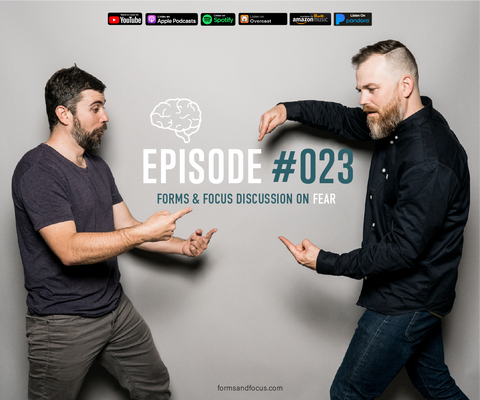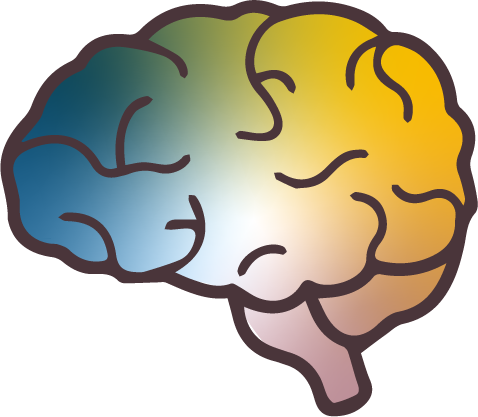
#23 Forms & Focus Discussion on Fear
MODERN DAY FEAR
Fear and anxiety are not the same, but both are killing your dreams.
Whether it’s a bear attack or fear of rejection, our brains may respond the same, run. The psychological impact of generational fear heightened by modern day fear mongering is training your brain to live in a constant state of FEAR. This separates us from our goals and dreams.
On today's episode of the Forms and Focus Podcast (EPISODE #023), we are discussing focus and fear. And what you can do TODAY to reverse the effects of fear on the brain, increase your focus on long-term goals and accomplish your dreams. Let’s dig in…
0:00 - Intro to Fear
0:39 - Podcast Intro
1:12 - Problem/Fear and how it impacts our focus.
14:36 - Solution/Habits for better focus.
LISTEN TO EPISODE
WATCH EPISODE
SHOW NOTES FOR EPISODE #23
PROBLEM WITH FEAR AND FOCUS
What Is Fear?
(APA Dictionary) Fear is an intense emotion aroused by the detection of imminent threat, involving an immediate alarm reaction that mobilizes the organism by triggering a set of physiological changes.
(Steimer, 2002) The main function of fear is to act as a signal of danger, threat, or conflict, and to trigger appropriate adaptive responses.
Your body will increase rapid heartbeat, redirection of blood flow away from the periphery areas of the body, tenses of the muscles, and a general mobilization to take action: fight-or-flight response.
How does the brain respond to fear?
(Lacagnina), IMMEDIATE THREATS (BEAR ATTACK):
The visual information comes in. It's getting into the visual processing pathway.
Then moves into the amygdala, which is the threat-detection center… or the “threat reflex” as Huberman Labs explains.
From there, the information is also flowing into the cortex. And we think that the conscious expression of fear is going to be really governed by cortical activity -- this is going to be the prefrontal cortex. (The strategic plan).
And so now you're going to want to maybe run away and have the defensive responses, whether fight or flight -- that's going to kick in.
All this while the body has cascading physiological responses to help you survive like we mentioned above.
How the brain stores information to prevent danger
(Anand and Dhikav) The Hippocampus is a complex brain structure embedded deep into the temporal lobe. It has a major role in learning and memory.
The amygdala is commonly thought to form the core of a neural system for processing fearful and threatening stimuli.
A FEAR MEMORY: (Ingvar) There is a pathway that runs from the thalamus to the amygdala, and sensory information about fearful stimuli may be sent along this pathway to the amygdala before it is consciously processed by the cerebral cortex. This allows for the initiation of a fear reaction before we even have time to think about what it is that’s so frightening.
(Pittalwala) Our study demonstrates for the first time that the formation of fear memory associated with a context indeed involves the strengthening of the connections between the hippocampus and amygdala."
What are we afraid of?
It is pretty rare to be attacked by a bear, (1 in 2.1M), odds of shark attack (1 in 3.7M, odds of being struck by lighting (1 in 500K), odds of being killed by any animal ( 1 in 1.6M) odds of being killed by terrorist attack (1 on 30M) odds of being killed by foreign‐born terrorists is (1 in 104M).
Fear is on the rise.
(Winkelmeyer) 54% said they're more fearful than hopeful about what's in store for the world in 2022, while 44% said they're more hopeful.
That's a sharp turnaround from last year's survey, when 63% said they were more hopeful about the world in 2021 and 36% said they were more fearful.
What do Americans Fear? (Amirazizi) The Chapman University Survey of American Fears Wave 7
1. Corrupt government officials - 79%
2. People I love dying (#5 in 2019) 58.5%
3. A loved one contracting the coronavirus (COVID-19) 58%
4. People I love becoming seriously ill (#3 in 2019) 57.3%
5. Widespread civil unrest 56.5%
6. A pandemic or a major epidemic 55.8%
7. Economic/financial collapse 54.8%
8. Cyber-terrorism (#7 in 2019) 51%
9. Pollution of oceans, rivers and lakes (#2 in 2019) 50.8%
10. Biological warfare 49.3%
To understand modern fear, we must understand anxiety.
(Contie) Anxiety disorders affect nearly 1 in 5 American adults each year.
(Society for Neuroscience) Fear -- a fleeting reaction to certain danger -- is thought to be controlled by the amygdala, whereas anxiety -- a persistent, heightened state of distress in response to an uncertain threat.
While anxiety was believed to be held in the stria terminalis, the major pathway between the amygdala and the hypothalamus, new evidence suggests these two brain regions are equally sensitive to certain and uncertain threats.
(Article on Baton Rouge Behavioral Hospital) said “While anxiety and fear feel similar, anxiety is a reaction to emotions instead of danger in the environment.”
The Psychology of Fear
(Albrecht) There are five basic fears:Extinction—the fear of annihilation, of ceasing to exist.
Mutilation—the fear of losing any part of our bodily structure.
Loss of Autonomy—the fear of being immobilized, restricted, overwhelmed, imprisoned, smothered, or controlled by thing beyond our control. It also extends to social interactions and relationships.
Separation—the fear of abandonment, rejection, and loss of connectedness; of becoming a non-person—not wanted, respected, or valued by anyone else.
Ego-death—the fear of humiliation, shame, or any other mechanism of profound self-disapproval that threatens the loss of integrity of the self.
Memories, Fear and Anxiety
Fear of money, how many kids saw their parents argue over money. Fear of relationships, how many kids saw their parents fit and get divorced. Fear of
Rejection, Fear of failure, fear of death, fear of being alone, fear of humiliation.
We are playing a different game, but the software is the same.
WE LIVE IN FEAR.
Internally and externally stimuli all strengthen our lizard brains, keeping us from our dreams.
This is why you are afraid to start a business and why you can’t trust a new business partner. This is why you are afraid to not only accomplish your dream, but to even dream at all.
The psychological impact of generational fear heightened by the modern day fear mongering media is training your brain to live in a constant state of FEAR.
When you live in fear, you are controlled by that fear. Your brain power to think and strategize is increased over the weekend and your fight or flight response is strengthened.
SOLUTION/ SO WHAT DO WE DO?
Huberman Lab: “There’s no negotiating what fear feels like, you can only negotiate what it means.”
How to undo fears: A traumatic Fear Experience:
Diminish the old experience through repetitive narrative. (Almost inevitably the first repetition of that will be very intense). Through repetition you’re telling a terrible upsetting story into a boring story. This is the extension process
The learning of a new narrative. The prefrontal cortex is amazing at attaching meaning to events. Narrative should not be undervalued as a tool for relieving fear & trauma. It’s a very strong way to rewire our brain and fear circuitry
Contrary to popular belief, it's not enough to simply extinguish a fear. One must extinguish and replace the fearful, traumatic memory, idea with a positive response. You must attach a positive experience with the previous trauma. “I enjoy riding bikes despite getting hit by a car once”
Article, “Neuroplasticity in response to cognitive behavior therapy for social anxiety disorder.” Further analysis indicated that diminished amygdala Gray Matter volume mediated the relationship between decreased neural responsivity and reduced social anxiety after cognitive behavior therapy .
Meaning, the brain actually changed after cognitive behavior therapy!!!!!
What You Can Do TODAY?
Fear has power when you don’t share it. If you suffer from severe anxiety, get help!!! But if you are looking for ways to improve your overall mental health, reduce the fear state, anxiety and start working on your dreams, here are some tips you can start today! A great article by (Lebow) in Psych Central pulls quotes from leading psychologist
Change the scripts: “If you want to focus on thinking and perception, you can develop new anxiety scripts that tell you a different story, one that makes you feel safe,”
Reality testing: Devised by Sigmund Freud, reality testing is a helpful way to shift your perspective around experiences that typically make you feel anxious.
Meditation: “Meditations with a focus on compassion and kindness can be very helpful as they help reframe thoughts, thus creating new brain pathways.”
Physical exercise: Accelerates changes in the brain’s structure at every level: molecular, cellular, and system.
New skills: Each time you learn a new skill, you’re increasing your brain’s ability to rewire itself.
RESOURCES
- How to 'overcome' fear | Trevor Ragan | TEDxCedarRapids
- Cutting through fear: Dan Meyer at TEDxMaastricht
- How Your Brain Processes Fear
- KNOW YOUR BRAIN: AMYGDALA LINK
- https://www.fitmind.co/
WORKS CITED
Albrecht, Karl. “The (Only) 5 Fears We All Share.” Psychology Today, 22 March 2012, https://www.psychologytoday.com/us/blog/brainsnacks/201203/the-only-5-fears-we-all-share. Accessed 4 April 2022.
Amirazizi, Roxy. “Survey on American Fears FAQs | Chapman University.” Chapman University, 2022, https://www.chapman.edu/wilkinson/research-centers/babbie-center/fear-survey-faqs.aspx. Accessed 4 April 2022.
Anand, Kuljeet, and Vikas Dhikav. “Hippocampus in health and disease: An overview.” NCBI, October 2012, https://www.ncbi.nlm.nih.gov/pmc/articles/PMC3548359/. Accessed 4 April 2022.
Contie, Vicki. “Scientists Switch Off Brain's Anxiety Circuit.” National Institutes of Health (NIH), 21 March 2011, https://www.nih.gov/news-events/nih-research-matters/scientists-switch-brains-anxiety-circuit. Accessed 4 April 2022.
“Fear vs Anxiety: Understanding the Difference.” Baton Rouge Behavioral Hospital, 21 October 2021, https://batonrougebehavioral.com/fear-vs-anxiety-understanding-the-difference/. Accessed 4 April 2022.
Ingvar, Martin. “On the unconscious subcortical origin of human fear.” PubMed, 10 September 2007, https://pubmed.ncbi.nlm.nih.gov/17599366/. Accessed 4 April 2022.
Lacagnina, Anthony. “Your Brain on Fear.” Mount Sinai, 30 October 2019, https://www.mountsinai.org/about/newsroom/podcasts/road-resilience/brain-fear. Accessed 4 April 2022.
Lebow, Hilary. “Rewire Your Brain: 6 Neuroplasticity Exercises to Relieve Anxiety.” Psych Central, 2 November 2021, https://psychcentral.com/anxiety/how-to-train-your-brain-to-alleviate-anxiety#neuroplasticity-exercises. Accessed 4 April 2022.
Månsson, K N T, and A. Salami. “Neuroplasticity in response to cognitive behavior therapy for social anxiety disorder.” NCBI, 2 February 2016, https://www.ncbi.nlm.nih.gov/pmc/articles/PMC4872422/. Accessed 4 April 2022.
“The overlap between fear and anxiety brain circuits: Contrary to previous theories, fear and anxiety reflect shared neural building blocks.” ScienceDaily, 21 September 2020, https://www.sciencedaily.com/releases/2020/09/200921130629.htm. Accessed 4 April 2022.
Pittalwala, Iqbal. “How associative fear memory is formed in the brain: Insights into how pathological fear memory in PTSD could be suppressed.” ScienceDaily, 13 March 2020, https://www.sciencedaily.com/releases/2020/03/200313112137.htm. Accessed 4 April 2022.
“Psychology.” APA Dictionary of Psychology, https://dictionary.apa.org/fear. Accessed 4 April 2022.
Steimer, Thierry. “The biology of fear- and anxiety-related behaviors.” NCBI, Sep 2002, https://www.ncbi.nlm.nih.gov/pmc/articles/PMC3181681/. Accessed 4 April 2022.
Winkelmeyer, Matt. “Exclusive poll: America's fears rise for 2022.” Axios, 31 December 2021, https://www.axios.com/america-fears-rise-2022-poll-e6684bee-e6bf-41be-919a-caf4cf9fb951.html. Accessed 4 April 2022.

Comments (0)
There are no comments for this article. Be the first one to leave a message!